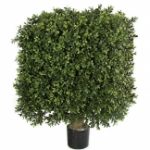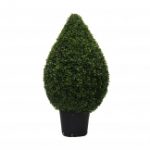
Most of us enjoy evergreen shrubs like boxwoods.
Why?
They hold steady throughout the year and provide a permanent framework to other plantings, which often disappear in the winter.
Plus, they take well to shearing.
So. why are your boxwood shrubs turning yellow…?
Here are Five Possible Causes:
1. Volutella fungus
2. Macrophoma leaf spot
3. Nematodes
4. Phytophthora root rot
5. Cylindrocladium buxicola
One that I want to point out and give you some possible substitutes, is Boxwood Blight (Cylindrocladium buxicola.) This is not a fun problem to have. And, since it was first discovery in Great Britain in the mid 90’s, it’s also been found in Europe, New Zealand, Canada and in 2011, within the U.S.
About Boxwood Blight

Boxwood Blight is caused by fungus, Cylindrocladium buxicola. The fungus spreads by wind, water, birds, animals and can also spread by contaminated clothing and shoes.
Unlike many fungal infections which spread when plant parts are injured and fungus invades, this fungus doesn’t need a wound to infect the plant.
Instead, it thrives on high humidity, moderate temperatures, and poor air circulation.
Like all diseases, this one also needs to have (1) a susceptible host, (2) the correct environment, (3) a pathogen present. In the case of Boxwood – English Boxwood (Buxus sempervirens) is most susceptible. Other species are less susceptible, but the keyword is ‘less.’ Within the boxwood family, plants such as Sarcococca and Pachysandra also show susceptibility to the disease.
Here’s a good FAQ on boxwood blight from Cornell Cooperative Extension.
What to Do if Your Boxwood has Boxwood Blight?
One option is to try to save it. Here’s a PDF from Bartlett Tree Experts that has good information on plant health care recommendations. See this about Boxwood Blight on Wikipedia .
Considering that the Blight thrives in humid conditions, opening up and thinning the boxwood to allow for more air to the its center is a good idea. This though is challenging when grown as a hedge designed to be full, closely planted and sheared regularly to be kept compact.
If you suspect your Boxwood has the blight a better option is to replace it with a good substitute not susceptible to the Blight.
Here Are a Few Good Alternatives:
Ilex crenata
Ilex vomitoria ‘Nana’ – good dwarf form for mild climates
Myrsine africana
Euonymus microphullus – susceptible to phytophthera
Happy Gardening!

 ps: If you’re not having any luck growing boxwoods or their suggested substitutes, consider the artificial alternative. Some locations are just too difficult sustain a live plant. Plus the faux versions have come a long way in recent years. Done right, it can by hard to tell the fake from the real thing. Check out these Outdoor Boxwood Shrubs from Artificial Plants and Trees
ps: If you’re not having any luck growing boxwoods or their suggested substitutes, consider the artificial alternative. Some locations are just too difficult sustain a live plant. Plus the faux versions have come a long way in recent years. Done right, it can by hard to tell the fake from the real thing. Check out these Outdoor Boxwood Shrubs from Artificial Plants and Trees